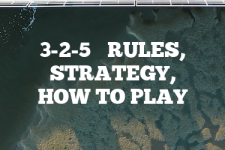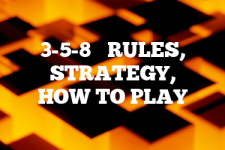The Intricacies of Bieten: A Guide to Rules, Instructions, Winning Strategies & How to Play
Introduction
Oh, Bieten! The card game that has been the cause of many a heated debate and the destroyer of countless friendships. This game, with its roots in the Netherlands, is a fascinating blend of strategy, luck, and the ability to bluff your way to victory. It’s a game that requires a standard 52-card deck and a minimum of three players, although it’s best enjoyed with four to six participants.

Bieten translates to bidding or betting. In this game, each participant is given only three cards, and points are awarded for the highest heart, highest leaf, best pair or triple, top sequence, and for winning the final trick. Players have the option to bet on any of these points: if the other players yield, the one who bet automatically secures the point; if they challenge the point, its worth amplifies.
Quick Tip for Bieten
Remember, in Bieten, it’s not just about the cards you hold, but how well you can convince your opponents of your hand’s strength or weakness. Bluffing is key!
Rules for playing Bieten
The rules of Bieten are relatively straightforward, but like any good card game, there’s always room for a bit of variation. The official rules dictate that each player is dealt five cards, and the aim is to predict how many tricks you can win. The player who bids the highest number of tricks leads the first round. However, some prefer to add a bit of spice to the game with ‘house rules’, such as allowing blind bidding or introducing penalties for incorrect bids.
The Weli in Bieten
The Weli can stand for any card not currently in the user’s hand. When the Weli is played during a trick, the player must declare what card it’s representing, specifying both rank and suit. This cannot be altered until the next deal.
The actual card that the Weli stands for may be held by another player. For determining the trick winner or any figures, the Weli is ranked just below the real card it represents. For instance, if a player uses the Weli as the ace of hearts, it can beat the king of hearts but not the real ace of hearts.
Similarly, two real kings would beat a real king paired with a Weli representing a second king. Keep in mind that the Weli cannot be used in a way that breaks the rule of following suit. For example, if you have the nine of leaves, the ace of bells and the Weli, and a heart is led to the first trick which you don’t follow, you cannot later declare your Weli as the ace of hearts. They didn’t follow suit to the heart lead, so their Weli can’t be a heart.
How to Play Bieten
Setup
Each player is dealt five cards, and the remaining deck is placed in the center of the table. The top card of the deck is turned face up to determine the trump suit.
Gameplay
The player to the dealer’s left starts the bidding process. Players take turns to either pass or bid a higher number of tricks than the previous highest bid. The player who bids the highest number of tricks leads the first round. The game continues clockwise, with each player required to follow suit if possible. If a player cannot follow suit, they may play a card from the trump suit or any other card. The player who played the highest card of the lead suit or the highest trump wins the trick and leads the next round.
End of the Game
The game ends when all tricks have been played. The player who correctly predicted the number of tricks they won is the winner. If no player correctly predicted their tricks, the player who came closest to their bid wins.
Betting in Bieten
Each figure initially has a value of one point. However, players can attempt to increase a figure’s value by placing a bet on it. For instance, if a player declares “I bet on the same (Gleich)”, they are suggesting an increase in the bet’s value to two points during that round. This can occur at any time, often just before a player makes a move. Whenever a bet is placed, the game pauses temporarily. The player to the left of the bettor is the first to respond, and then the turn proceeds clockwise. Each player must decide whether they agree to the increase. If a player wants to compete for the figure at two points, they say “ich halte” which translates to “I hold”. If they are fine with the bettor securing one point without competition, they simply say “gut” meaning “good”.
In a betting game, a bettor wins one point if all other players say “good”. However, if any player holds, the figure’s value rises to two points, and no other players can speak. The player who wins this figure scores two points. This player could be the bettor, the player who held, or another player. A player who previously said “good” can win the figure if another player holds it.
To place or hold a bet on a figure, you must have that figure in your hand. For instance, you can only bet or hold a bet on red if you possess at least one heart card. Similarly, to bet or hold a bet on the Gleich, you need two identical cards. The same concept applies to other figures.
Once the first card of the final trick has been played, you are not allowed to bet on or hold the Game unless you possess a card of the same suit that was initially played in the trick.
Bear in mind that if you choose to use the Weli as the basis for your betting or holding strategy, it then becomes a necessary card for legitimizing your bet or hold. Let’s say you have the Weli and the King and Ober of bells in your hand. You can place a bet on Green, planning to transform your Weli into a high leaf, but even with everyone’s approval, you cannot subsequently place a bet on Red. This is because your Weli cannot simultaneously be a heart and a leaf. You can also bet on Gleich, but in this case, your Weli would need to be the King or Ober of leaves. If your opponent, who accepted your Green bet, ends up having the King of leaves, you cannot outdo this by turning your Weli into the Ace of leaves if you’ve also placed a bet on Gleich.
In the Alpine (German language) version of the game, after a bet has been placed on a figure, any player, excluding the original bettor, can attempt to increase the score for that figure from two to three points, by saying phrases such as “Drei für die Roten” (Three for the red) or “Ich gebe einen Groschen” (I give a Groschen – a small coin worth three Kreuzer). You cannot increase the bet on any figure more than three points. Following this, starting with the player to the left of the one who raised the bet to three, the rest of the players can say “gut” (good) if they agree to let the player who raised the bet to three have two points for the figure without any competition. However, if any player opts to accept the raise to three by saying “ich halte” (I hold), there’s no need for the subsequent players to respond, as the figure’s winner will then earn three points.
How to Win at Bieten
Winning at Bieten requires a blend of strategy, observation, and a good poker face. Here are some strategies to consider:
- Pay attention to the bids: The bidding process can give you valuable insights into the strength of your opponents’ hands. Use this information to adjust your strategy accordingly.
- Bluffing: Bieten is as much about psychology as it is about card play. A well-timed bluff can throw your opponents off and give you the upper hand.
- Card counting: Keeping track of the cards that have been played can help you predict the cards your opponents hold.
Best Strategies for playing Bieten game
While there’s no surefire way to win at Bieten, here are some strategies that can increase your chances of victory:
- Control the game: Try to control the game by leading with strong cards. This forces your opponents to play their high cards early, giving you an advantage in the later rounds.
- Play your trump cards wisely: Trump cards are your most valuable assets in Bieten. Use them strategically to win crucial tricks.
- Adapt your strategy: No two games of Bieten are the same. Be flexible and adapt your strategy based on the cards you’re dealt and the bids of your opponents.
Scenarios for Bieten
Every game of Bieten presents unique scenarios that require strategic thinking. Here are some common situations and how to handle them:
- You have a weak hand: If you’re dealt a weak hand, it’s best to bid low and play defensively. Try to force your opponents to play their high cards early, and save your trump cards for the later rounds.
- You have a strong hand: If you have a strong hand, bid high and play aggressively. Lead with your high cards to control the game and force your opponents to follow suit.
- You’re unsure of your hand’s strength: If you’re unsure of your hand’s strength, it’s best to bid conservatively. Observe your opponents’ bids and play to try and gauge the strength of their hands.
Frequently Asked Questions about playing Bieten game
Here are some common questions about Bieten:
- What is the minimum number of players required to play Bieten?
Bieten can be played with a minimum of three players, but it’s best enjoyed with four to six participants. - Can I play Bieten with more than six players?
While it’s possible to play Bieten with more than six players, it can become chaotic and less strategic. - What happens if no player correctly predicts their tricks?
If no player correctly predicts their tricks, the player who came closest to their bid wins. - Can I change my bid?
Once you’ve made your bid, you cannot change it. This is why it’s important to think carefully before making your bid. - What is the role of the trump suit in Bieten?
The trump suit is the highest suit in the game. If a player cannot follow suit, they may play a card from the trump suit to win the trick.
External Links
For more information about Bieten, visit the official game website here.

A digital native around since the early days of online gaming communities around 2001. An early contributor to the cult gaming site ClanTemplates, Adam has spent years giving free gaming resources to the community. With BoardCards, Adam is most experienced and commonly writing the articles on Strategy multi-player games like Settlers of Catan and Avalon. His first introduction to board games was via Mancala, an Egyptian-origin stone game and one of the oldest known games still played worldwide. Contact me via email



